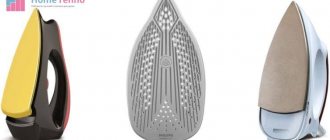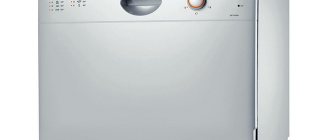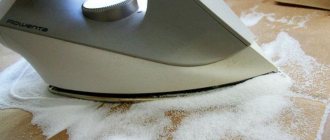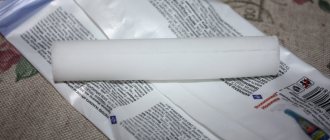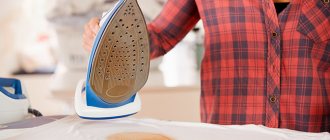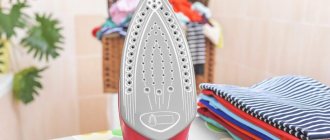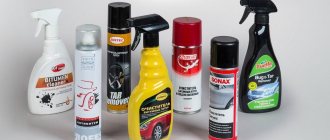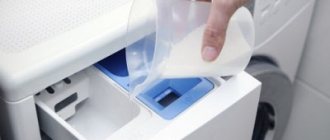All household appliances used in the household require regular maintenance. A device for ironing clothes is no exception, because its working surface with traces of scale and dirt can cause damage to the fabric. Incredibly, you can clean your iron with toothpaste. An inexpensive and accessible product will cope with this problem no worse than store-bought sprays and pencils. The main thing is, depending on the material of the sole, choose the composition suitable for cleaning and follow the instructions.
Outsole material
First, let's talk about what material the sole of your iron can be made of. It depends on the material which recipes you can use to clean the soleplate of your iron at home.
And which ones cannot be used, because... they may damage the device.
Manufacturers choose the following materials:
- Aluminum . Perhaps one of the most popular materials, because... it belongs to the budget category. Aluminum also conducts heat well, is lightweight, but cannot be said to be durable and reliable. For example, an aluminum sole can leave a hole in a T-shirt if the temperature is not adjusted correctly. And you can’t iron the wool at all.
- Stainless steel . The iron will cost more, but its quality will be better. The sole heats up evenly, which minimizes the possibility of damaging the fabric. Stainless steel is durable and resistant to rust and damage. Therefore, you can safely choose even rough cleaning of the iron to remove burnt marks on the sole.
- Ceramics . It glides easily, removes wrinkles well and heats up evenly. Also, threads and fibers do not collect on the sole, and there are no puffs left on clothes.
- Teflon . A good iron for delicate items. But you also need to handle it carefully, because... Scratches may appear on the surface, and Teflon itself wears off faster than other materials.
All the recipes that we will discuss below are suitable for cleaning the ceramic soleplate of an iron.
But to clean the soleplate of a Teflon-coated iron, pay attention to only two methods:
- Pencil.
- Vinegar 70%.
What pastes are best to use for cleaning?
Conventionally, pastes can be divided into two categories:
- Soft. Such products contain mainly urea and organic acids, but they contain few abrasive substances. They are quite expensive, but are good for caring for sensitive teeth and other surfaces.
- Abrasive. The composition contains calcium phosphates, baking soda, aluminum oxide, carbonates and other substances with grinding properties. Teeth care products are designed for whitening and do a good job of treating and preventing hard tartar, as well as cleaning stains. However, it is best not to use them on any sensitive surfaces to avoid microscopic scratches.
A video about how to clean an iron with toothpaste recommends that when choosing a product, you should follow the same principle as when purchasing an oral care product. If the base of the heating device is metal or ceramic, it is permissible to use inexpensive abrasives; they will help deal with dirt. But to clean the Teflon platform, you should purchase only gentle varieties with urea and acids. Otherwise, damage will remain on the surface.
From the assortment presented in stores, several brands are best suited for household appliances.
Rembrandt Plus
The American product is designed for gentle whitening and removal of plaque and tartar. It contains monofluorophosphate and carbamide peroxide, which do not have an abrasive effect. The disadvantages include the high cost - around 400 rubles.
Rembrandt Plus is suitable for cleaning units with Teflon soles
SPLAT Extreme White
A special domestic paste contains carbamide peroxide and silicon, as well as sodium fluoride. It is intended for sensitive oral cavity, so it can be used to clean irons with Teflon-coated soles; it will not leave scratches on their surface.
ROCS PRO
Another composition from the expensive category has a soft consistency and does not include coarse abrasives. The removal of plaque and tartar is achieved due to the presence of calcium glycerophosphate and carbamide peroxide. The product can be used to clean the soleplate of any iron; there will be no scratches on the platform, and dirt will come off quickly.
ROCS PRO price starts from 290 rubles
Cedar balm
The Russian product belongs to the abrasive category and contains calcium carbonate. It is not suitable for devices with a Teflon surface, but you can wash the iron with toothpaste if it has a metal sole.
The cost of Cedar Balsam starts from 70 rubles
New Fluorodent
The paste contains abrasive particles - sodium bicarbonate and calcium carbonate. In oral care it is used for whitening purposes. When cleaning heating appliances, it effectively removes lime deposits and old fumes from steel and ceramic soles.
The price of New Fluorodent paste starts from 30 rubles
Recipe 1: Clean the soleplate of the iron with salt
Ingredients:
- Salt.
- A blank sheet of paper or cardboard.
How to clean the soleplate of your iron with salt:
- Spread the salt in one layer on a clean sheet of paper or cardboard.
- Split the iron.
- Run the iron over the salt scattered on the sheet, pressing the soleplate firmly. The salt will remove all the carbon deposits from the surface.
Important! Please note that this recipe is not suitable if you need to clean the soleplate of a Teflon iron. Because Coarse salt can scratch it.
Method 6. Soda
Soda is a good thing, but for baking. For cleaning, it is not the best option, since it does not have any special solvent properties. If we are talking about abrasive cleaning, then yes, here you go. But, this is all for old models, as you remember.
Cleaning the iron with soda:
1. Wet a clean cloth with water, wring it out well, and put baking soda on it.
2. Rub the surface until it is clean.
If there is burnt tissue on the sole, remove it with a knife first. And cleaning with soda is the second stage. It cannot be said that this method will rid the iron of dirt quickly. Most likely, the procedure will have to be done several times.
Recipe No. 2. How to clean the soleplate of an iron with vinegar?
Ingredients:
- Vinegar.
- Cotton wool, cloth or towel.
- Water.
How to quickly clean the soleplate of your iron with vinegar:
- Option 1 . Soak cotton wool in vinegar and wipe the areas where the burnt marks appear. There is no need to turn on the iron.
- Option 2 . Soak a cloth in vinegar and place a warm, but not turned on, iron on it. Leave the device in this position for several hours. And then wipe dry with a clean cloth.
- Option 3 . Combine 2 tbsp. l. vinegar with a glass of water. Soak a towel in the solution and iron it with an iron operating at medium heat. The best option for large stains.
This recipe is suitable for cleaning the ceramic soleplate of an iron, as well as Teflon, if you use 70% vinegar.
What do we need?
Ceramic is a very fragile material that can be easily scratched by accidentally ironing metal buttons or zippers on clothing.
You need to clean the iron extremely carefully , using soft rags, sponges and detergents without abrasive particles.
There are many special chemicals that will help make the soleplate of the iron perfectly clean; home remedies are also suitable for removing stains: lemon, vinegar and others.
8 recipes on how to clean a ceramic stove from carbon deposits are presented here.
Recipe No. 3. How to clean the soleplate of an iron with soda?
Another remedy that you always have at home is baking soda. It will also cope with cleaning the soleplate of the iron from carbon deposits.
What to take:
- Baking soda (plus extra hydrogen peroxide).
- Water.
- Capacity.
How to clean the soleplate of an iron with soda:
- In a container convenient for you, combine baking soda and water, you should get a thick paste.
- Rub the mixture into the sole.
- Then rinse the solution with water and wipe clean.
Second way:
- Heat the iron to the highest possible temperature.
- Soak the sole with peroxide.
- Wait until it cools down.
- Apply a mixture of baking soda and water to the cold sole.
- Wait about 7 minutes. and rinse off the residue, and then wipe the surface with a clean cloth.
Important! We remember that soda is contraindicated for cleaning the soleplate of a Teflon-coated iron.
Chemicals
In addition to gentle care, chemicals for cleaning glass ceramics form a thin, invisible protective layer on the treated surface , which promotes better glide of the electrical appliance over the items being ironed and prevents scratching of the coating during operation of the iron:
- Wpro cleaning cream – does not contain alkalis. To clean the sole, apply the product to it with a cloth, after 5-10 minutes wipe the contaminated areas with a soft sponge, remove any remaining cream with a damp cloth and dry the surface.
- Cif Active is a cream containing microgranules that can cope with the most persistent plaque and grease stains. Apply the product to the sponge and distribute it on the ironing element. Remove dirt after a few minutes with a damp cloth and wipe the sole with a dry towel.
- Bagi Shumanit is a powerful spray for removing stains of various origins: move the spray valve to the working position, apply the product to the iron and after 5-10 minutes wipe the surface with a damp sponge.
- Kenolux Grill is a dark brown product with high cleaning power. Spray the chemical liquid onto the problem areas of the surface, after 5-7 minutes, wash off the dirt and remaining substances with a damp sponge, wipe the iron with a dry cloth.
- Top Hause for irons - includes a special cleaning stick, liquid cleaner and cloth. The kit allows you to care for the sole of the device and remove limescale from the internal surfaces of the device. The napkin is designed to remove pencil residues after cleaning the ironing element.
IMPORTANT! Cream Cif Active, Bagi Shumanit and Kenolux Grill can only be applied to cold soles! When using chemicals, use rubber gloves to protect your hands.
Recipe No. 4. Cleaning the soleplate of the iron with laundry soap
It will help if you decide to clean the ceramic sole of your iron at home, but the carbon deposits on it are not strong.
What to take:
- Laundry soap.
- Warm water.
- Capacity.
- A napkin or cotton swab, cotton swabs.
How to clean the soleplate of an iron with laundry soap:
- Preheat the iron at minimum temperature.
- Rub the surface with a bar of soap.
- Wait until the soap softens the carbon deposits.
- Remove soap residue with a napkin or disk, and treat the steam holes with a cotton swab.
Second way:
- Dissolve crushed pieces of soap in warm water.
- Use a napkin to wipe off the soot as much as possible.
- Apply a soap solution to a dry sole heated at a minimum temperature.
- Wait 20 min.
- Wipe the surface with a clean cloth.
Cleaning the iron coating from carbon deposits
To clean the device from burnt fabric, you need to do it correctly.
It is important to remove carbon deposits in such a way as not to scratch the soleplate of the iron. Due to scratches, the metal begins to rust, which means it will not be able to iron things efficiently.
Not all irons have a non-stick coating, so models such as Vitek or Bosch should be periodically cleaned of carbon deposits.
You can clean an iron with a steel, stainless, or aluminum sole using gentle abrasives such as salt or soda.
Cleaning the burnt surface of the iron sole with baking soda paste allows you to polish the iron sole to a shine at home. To prepare the paste, mix two teaspoons of baking soda with a small amount of water or vinegar. The consistency of the paste should be soft and thick.
Let's look at the cleaning rules step by step:
- Turn on the iron and warm up the thermal platform until warm.
- Apply the prepared baking soda paste to the surface of the iron and leave for ten minutes.
- Clean the surface of the iron using a cotton cloth.
It is easy to clean the iron with baking soda and gently remove abrasive and burnt residue from the surface of the soleplate of the device.
There are two ways to clean your iron with salt:
- Apply a handful of salt to a slightly heated sole and rub with a cotton cloth;
- Heat the iron to maximum heat, and pour salt onto the cloth or parchment, spreading it in an even layer. Place the iron horizontally for a few minutes, then iron. This will help clean the burnt marks and effectively remove contaminants.
The use of vinegar solution differs from previous methods of cleaning with soda and salt. This solution can be used to clean your iron and ceramic soleplate. This solution can easily clean the holes, surface and soleplate of the iron.
The treatment liquid is prepared by diluting vinegar with water in equal proportions. The iron is cleaned with a cotton cloth soaked in the solution. And holes and hard-to-reach places are cleaned with cotton swabs dipped in a vinegar solution.
Iron parts with steel, ceramic, or stainless soles can be easily cleaned with a vinegar solution.
Melamine sponges should not be used to clean the iron, as this will damage the soleplate of the iron.
Recipe No. 5. How to clean the soleplate of an iron with toothpaste?
Cleaning the soleplate of your iron with toothpaste is very easy.
What to take:
- I love any toothpaste.
- Brush or soft cloth.
- A napkin.
How to clean the soleplate of your iron with toothpaste:
- Apply the paste from the tube to the contaminated areas of the sole.
- Rub with a toothbrush or cloth until clean.
- Wipe the surface clean with a damp cloth.
This method is best suited if you are thinking about how to clean the soleplate of a ceramic-coated iron.
Types of coatings
Typically, the soleplate of the iron is made of aluminum or stainless steel. For better glide, a special coating is applied to its surface, which can be different:
- Titanium. Its advantages are durability and strength.
- Ceramic or glass ceramic. This sole glides easily over things and is quickly cleaned, but if handled carelessly, chips and scratches may occur.
- Teflon. The material is resistant to synthetic fabrics even when overheated.
- Enamel. It is difficult to scratch, but may crack over time.
The choice of cleaning method depends on the type of coating. The main task is to completely clean the device from dirt and not scratch the surface.
Recipe No. 6. Cleaning the soleplate of the iron with a pencil
You can buy a pencil at a hardware store. But before you clean the soleplate of the iron with a pencil, read the instructions that come with it.
It is also better to carry out the procedure in a ventilated area, because... Substances contained in the pencil may evaporate and produce harmful smoke.
What to take:
- Pencil.
- Soft napkins or cloth.
How to clean:
- Preheat the iron to the temperature specified in the instructions for the pencil.
- Use a pencil to work on the problem areas on the sole. But do not press too hard so that it does not crumble under your fingers. Otherwise, pieces of pencil may get into the steam holes and the operation of the iron will be disrupted.
- The pencil will melt under the influence of temperature.
- Use a soft cloth or rag to remove any remaining dirt, and after the iron has cooled down, wipe the surface with a dry and then a wet cloth.
Suitable for cleaning the soleplate of an iron with any coating: ceramics, metal, Teflon.
Glass ceramic cleaning products
Preparations and substances that are used to remove plaque and grease from glass-ceramic surfaces can be used for the same purposes for ceramic-coated irons.
Hydrogen peroxide
The use of this method is absolutely safe for fragile ceramics.
Procedure using 3% hydrogen peroxide:
- Place the electrical appliance in a vertical position. If you have recently ironed things with the device, let it cool completely;
- soak a cotton pad or napkin in the liquid preparation and, with a little force, wipe away any accumulations of plaque from the heating surface.
You can deal with heavy carbon deposits or limescale using this method:
- turn on the iron, set the high-temperature mode;
- wet a thick linen or cotton cloth with hydrogen peroxide;
- iron the wet material until the sole is clean;
- turn off the power, let the device cool down a little and remove deposits from the steam outlets using cotton swabs soaked in the preparation.
Lemon juice
Small fresh stains of grease or plaque that appear on the iron can be quickly removed with the help of fresh lemon:
- squeeze the juice from half the fruit (or use a whole citrus, depending on the area of contamination) and mix with a small amount of water;
- soak a cotton pad in the acidic liquid and wipe the problem areas on the cold base of the device.
REFERENCE! If fruit is unavailable, use an aqueous solution of food grade citric acid instead (a tablespoon of powder per glass of liquid).
Vinegar
This is a natural remedy that contains food grade acetic acid . The drug is widely used not only for cooking, but also for cleaning and disinfecting surfaces made of various materials.
For ceramic coatings, it is advisable to use 6-9% table vinegar, since a substance with a higher acid concentration can damage the surface of the sole.
The cleaning procedure is similar to the procedure using lemon juice:
- heat the iron as high as possible, turn off the power supply;
- soak a cloth in vinegar and carefully clean the contaminated area of the ceramic surface;
- Use cotton swabs soaked in an acidic solution to clean the holes for steam to escape;
- turn the device back on and iron some unnecessary clean fabric or item.
Toothpaste
The basis of hygiene products are abrasives and detergents - surface-active components that ensure the ability of the paste to foam and clean teeth.
Thanks to this, the mass intended for oral care can also be used to remove contaminants of various origins from household appliances:
- heat the iron to high temperature, turn it off;
- squeeze the paste onto a clean cloth and carefully apply it to the problem areas of the soleplate of the device, leave the product on the iron until it is completely dry;
- Use a damp sponge to remove any remaining mass and wipe the ironing element of the device with a dry towel.
IMPORTANT! The paste should have low abrasiveness.
Toilet soap
If you notice that after ironing a stain of soot or grease has appeared on your iron, the “fresh” nuisance can be removed with solid toilet soap (preferably light in color) :
- heat the iron, then turn off the electrical appliance;
- take a bar of soap and rub the sole with it, paying special attention to the most contaminated areas;
- After 40-50 minutes, remove the mass with a damp cloth and dry the sole.
ATTENTION! During the procedure, do not keep the soap in one place for a long time - the molten mass may flow into the steam outlet channels and it will be difficult to remove them.
Acetone
For delicate cleaning of fragile ceramic coatings, acetone, a solvent for paints containing this substance, or a nail polish remover (without herbal additives and color pigments) are suitable.
Treat the sole with the preparation after the electrical appliance has completely cooled : soak a rag in acetone and thoroughly wipe the contaminated area, treat the surface with a damp sponge and dry with a napkin.
Be careful: it is strictly unacceptable to get the product on the plastic elements of the iron.
Baking soda
Despite the fact that sodium bicarbonate is an abrasive substance, it can also be used to remove dirt from the sole:
- let the iron cool completely;
- make a solution: mix 1 teaspoon of soda and 100 ml of water;
- wipe the ironing element with a cloth soaked in the resulting liquid;
- treat the surface with a damp sponge and dry with a towel.
Baking soda is a great helper in cleaning your microwave oven, inside and out.
Matchbox
Matches will help quickly remove fresh dirt from ceramics . More precisely, this can be done using a spread - a brown mass applied to the sides of the box, against which matches are rubbed to ignite them.
This substance contains many components (red phosphorus, stibnite and others), among which there is chalk and crushed glass, thanks to which it becomes possible to return the radiant appearance to the sole of the electrical appliance:
- turn on the iron, set the regulator to maximum temperature;
- as soon as the device is hot, turn it off and carefully wipe the stains on the ironing part with the side of the box with the lubricant;
- Treat the surface after it has cooled with a damp sponge, then with a dry cloth.
Antiscale
A product for removing lime deposits based on a mixture of organic and inorganic acids, presented by the manufacturer in the form of a dry powder, which requires dilution with water in a certain proportion before use, or in liquid form :
- pour the solution prepared for use into the iron reservoir;
- turn on the device at full power;
- when the device heats up, take it and hold it horizontally over some container (bowl, basin or over the sink);
- press and do not release the steam button until all the liquid in the reservoir has been used up.
Cleaning pencil
The method using a product made in the form of a pencil is very simple and effective in removing carbon deposits, soot, grease and other contaminants from ceramic coating on the sole:
- heat the iron (to a temperature of 120-140 ⁰ C), turn off the power to the device;
- Apply a pencil to the ironing surface. Act quickly to prevent melting material from flowing into the steam vents.
After the sole has cooled, wipe it thoroughly with a clean cotton cloth.
ATTENTION! During contact with the hot surface of the iron, the product emits a pungent odor, so carry out the procedure without bending over the electrical appliance.
Bag of salt
- pour half a glass of finely ground salt onto a piece of spread cloth (linen or cotton);
- wrap the edges of the flap so that the crystals do not spill out of the resulting bag;
- turn on the iron, wait until it becomes warm, turn off the power and place the device vertically;
- With light movements, without pressure, use a bag of salt to remove dirt from the surface of the sole.
Recipe No. 7. Cleaning the soleplate of the iron with a candle
An analogue of a pencil for quickly cleaning the soleplate of an iron at home is the usual paraffin candle. But it can handle light stains.
What to take:
- A candle.
- Fabric or paper.
- A napkin.
How to clean the soleplate of an iron with a candle:
- Heat the iron to a high temperature, but you will have to select it experimentally.
- Wrap the edge of the candle that you hold in your hand in cloth or paper.
- Apply the candle to the surface of the iron, but hold it at an angle to prevent wax from getting into the holes.
- Let the device cool down.
- Remove any remaining wax and dirt with a napkin.
Causes of rust
Sometimes the surface of the iron and clothes that have been ironed are covered with brown streaks, splashes and stains.
There may be several reasons for this problem:
- The silicone gaskets inside the steam generator have deteriorated. This is due to the failure of the thermostat, which does not turn off the device in time and leads to its overheating and damage to the gaskets. There is only one way out - to take the equipment for repair. Gaskets can also be damaged due to the use of scale solvents and improper cleaning of the steam generator.
- Both scale and rust accumulate inside the appliance. It is formed when water comes into contact with poorly insulated metal parts. If metal elements have rusted inside the equipment, then it will not be possible to repair it.
Recipe No. 8. Cleaning the soleplate of the iron with hydrogen peroxide and ammonia
What else can you use to clean the soleplate of your iron? Peroxide and ammonia!
What to take:
- Hydrogen peroxide.
- Ammonia.
- Water.
- Capacity.
- Textile.
How to clean the soleplate of an iron with hydrogen peroxide and ammonia:
- Mix five drops of ammonia and half a glass of water in a container.
- Wipe the base of the device with the solution.
- Dry with a cloth.
Vinegar
This is the simplest and most time-tested method for fresh and old burnt marks. You don’t have to worry about the smell—it’s enough to ventilate the room well for it to go away.
You will need:
A few tablespoons of table vinegar and rock salt.
What to do:
In a metal bowl or saucepan, mix half and half vinegar and salt, put on low heat and wait until the salt dissolves. Be careful not to allow the vinegar to boil. Cool the mixture and wipe the surface of the iron with a soft rag or sponge. If any stains remain, leave the mixture on them for just a couple of minutes and wipe with a soft brush. Remove the remaining solution with a napkin and iron the unnecessary rags several times with a heated iron before use.
Photo: rabota-line.online
Recipe No. 9. How to clean the soleplate of an iron with solvent?
This recipe will help not only clean the iron from burnt soles, but also get rid of delicate fabric, polyethylene, etc. stuck to the surface.
What to take:
- Nail polish remover or B-47.
- A cotton pad or fabric made of natural material.
How to clean the soleplate of an iron with solvent:
- Dampen the disc or cloth with solvent.
- Wipe the cold soleplate of the iron.
- Remove any residue with warm water and wipe the surface dry.
Important! During the procedure, the surface of the iron should be cold.
How to remove traces of synthetics?
If synthetic fabric sticks to the iron while ironing, immediately turn off the device, let it cool and immediately begin removing carbon deposits. You can use both ready-made chemicals and folk remedies to eliminate the problem.
First of all, get rid of material fibers stuck to the sole: soak a rag in acetone and wipe the ironing element, clearing it of synthetics.
If this method does not help, try carefully removing the thick deposit with a wooden spatula (ruler) or a special silicone scraper designed for glass-ceramic stoves. Next, follow these steps:
Next, follow these steps:
wet a piece of clean cloth in warm water and wring it out; Sprinkle soda powder evenly over the material, wait a little until the crystals of the product begin to dissolve; Carefully, without force, wipe the cold sole with a cloth and soda, remove any remaining product and dry the treated surface.
You can enhance the cleansing effect of this method by squeezing a little lemon juice onto the baking soda.
Prevention and care tips
To avoid cleaning your iron so often from carbon deposits on the soleplate, follow the following preventive measures and listen to the advice:
- If you suddenly make a hole in the fabric and it sticks to the sole, apply cotton soaked in cold water to this place. This will help peel the fabric away from the sole.
- When cleaning, do not use rough brushes, sponges, napkins, etc. Especially when it comes to ceramics or Teflon.
- Avoid abrasive cleaners.
- Do not leave water in the iron after ironing; drain it into the sink.
- Use clean water, not tap water.
How to avoid carbon deposits
To avoid the appearance of carbon deposits, take care of it in advance.
about prevention. It is enough to follow the operating instructions: iron each type of fabric at the appropriate temperature. A maximum of +175° is suitable for cotton, up to +220° for linen, and no more than +120°C for silk. For items made of wool or synthetic fibers, it is recommended to use damp gauze.
In addition, only clean clothes should be ironed. Dirt particles can stick to the soleplate of the iron, causing carbon deposits to form. And one more tip: clean the soleplate after each use of the iron. Then it will always be clean.
